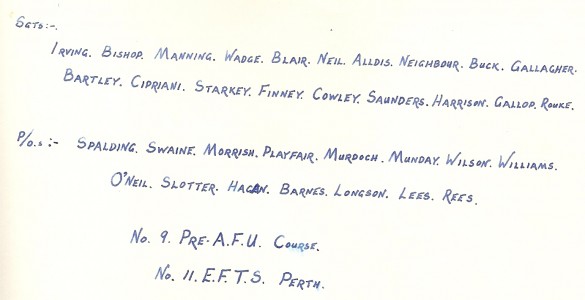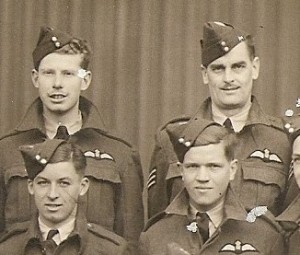
No 9 pre AFU course – Sgt Buck
The gentleman to the right of Stanley Neighbour and behind Roy Gallop is Sgt Buck. Without initials a positive identification is difficult. Did Sgt Buck survive the war? Or, as with Roy Gallop, Frank Wadge, Stanley Neighbour and Mervyn Cipriani – did he gave his life in the service of his country?
This calls for some ‘bad’ history on my part – conjecture, educated guessing – in the hope that someone who knows for certain will comment.
Assuming that Sgt Buck came to operations with Bomber Command it is likely he embarked on ops at the back end of 1943 as did his colleagues, already identified.
1399457 Sgt John Anthony Buck died on the Kassel operation of 20th/21st October 1943 flying as second pilot with W/O B E E Allden in Halifax LW301 of 78 Squadron. W/O Allden, Sgt Buck and a/g Sgt G A Nelson were killed, the remaining crewmen survived to become prisoners of war. Theo Boiten suggests that W301 was shot down by Oblt Gustav Tham of 11./NJG5 while a website detailing Gunter Radusch’s career credits him with the abschuss. John Buck was only twenty years of age when he died (six months or so after this pre-AFU photo was taken) – Sgt Buck looks a good ten years older, I feel.
Just over a month after John Buck’s demise another pilot with the same surname lost his life flying for Bomber Command. 1378810 F/Sgt Robert Moscrop Buck of 428 (RCAF) Squadron, had all but completed a sortie to Stuttgart and back when, making his approach to land, his Halifax was in collision with a Lancaster.
The planning for the main attack on Berlin required a diversionary raid on Stuttgart which was undertaken by 157 Halifaxes and 21 Lancasters which split off from the main force when the bomber-stream approached Frankfurt.
428 Squadron ORB Summary recorded the following for 26th November 1943:-
‘Sgt Gay flew an aircraft to Topcliffe to have tail assembly changed.’
‘After much scrambling and ‘bags of flap’ eleven aircraft were detailed for attack on Stuttgart.’
‘P/O Armour didn’t leave the ground, remainder bombed target and returned safely.’
‘F/Sgt Buck and crew were killed as a result of an air collision with a Lancaster diverted to this Station.’
‘F/Sgt Buck had permission to land and was at a height of approximately 200 feet when the Lancaster (which did not have permission) also tried to land, colliding with our aircraft. Both crashed and burned.’
F/Sgt Buck had narrowly missed a collision over the target just after bombing Dusseldorf on the night of 3rd/4th November, his previous operation. Having bombed a concentration of green T.i.s at 19.24 hrs from 20,000 feet – ‘While camera was operating it was necessary to do a violent climb to avoid a four engined aircraft, approaching from starboard on a heading of approximately 300 degrees.’
Halifax V – serial -N – LK924. Up 16.24 dn 22.56
1377810 F/Sgt Buck R M
1566041 Sgt Bruce W B
R161159 Sgt Wade W H
1565141 Sgt Muir J N
1316618 Sgt Biggs A H
1856742 Sgt Shirvell L J
R108715 Sgt Lindsay E J
The crew was unchanged for their next operational sortie – 26th/27th November – Stuttgart –
Halifax II – serial -V – JN966. Up 16.51
‘On return to aerodrome this aircraft collided with a Lancaster and as far as is known no Interrogation can possibly be made. It has been presumed that the Primary target was attacked. All members of the crew were killed.’
The Lancaster was ED417 of 103 Squadron, pilot F/O Robert Brevitt and the incident was briefly alluded to in connection with F/Sgt Val Richter’s penultimate sortie. The 103 Squadron ORB noted that on return F/O Brevitt and all his crew were killed, with the exception of mid-upper gunner Sgt Bowyer, who was seriously injured, when their aircraft collided with a Halifax while approaching to land. ‘This was shockingly bad luck as they had obviously done the distance and were back with the main stream.’
As visibility had deteriorated just as the aircraft were returning, most were diverted by R/t to Middleton St George, but after the above crash from there they were diverted elsewhere.’
Robert Moscrop Buck was born in 1913 in Northumberland, the second of five siblings, Margaret, Robert, George (after their father), Frederick and Mary – as was the fashion of the time Robert had received his mother Eleanor’s maiden surname Moscrop as his middle name. Robert married Anne H Geddes in late 1939 and the couple appear to have had two sons, Douglas, born in 1940 and Alastair 1943. At the time of Robert’s death Anne was living about fifteen miles away from Middleton St George at Brompton-on-Swale.
F/Sgt Robert M Buck was buried in Harrogate (Stonefall) Cemetery, he is commemorated on Whittingham War Memorial, Northumberland. The 1939-45 Book of Remembrance for Duke’s School, Alnwick has the following entry (which I hope they will not mind me reproducing here, apologies):-
‘R.M. BUCK :-
Robert M. Buck, son of Mr. and Mrs George Buck, born 14 May 1913, Aln View, Glanton, school at Glanton then Duke’s from 14 September 1925 to 26 July 1929. Alnwick Castle Estate Office, then R.A.F. Date of death December 1943, aged 30. Bert trained in Canada and became a Pilot in Bomber Command, having joined the R.A.F. in 1940. In June 1941 he crashed and was seriously injured, being off duty for twelve months. As a Flight Sergeant he returned to operational flying and was killed in an air crash on return from night operations over Germany. He was buried at Harrogate in December 1943, aged 30 years.'
Robert’s service number 1378810 is from the sequence associated with Euston Recruiting Centre from August 1940 (1375001-140000).
I have not yet been able to trace details of the crash in which he was seriously injured. However, it may have been during the early stages of his pilot training – which could have delayed him sufficiently (resuming training July 1942 onwards) for him to have found himself at 9 pre-AFU in February 1943. Roy Gallop had graduated from Arnold Scheme class 42J in November 1942.
The Sgt Buck in the photograph certainly looks to be nearer thirty than twenty years old. My best guess is that the gentleman beside Stanley Neighbour may well be Robert Moscrop Buck.
Robert’s headstone includes the inscription – ‘In God’s keeping, till we meet again’.
In the interests of completeness other possibles for Sgt Buck are:-
949578 F/Sgt Ben Buck, pilot, was commissioned as P/O 157699 wef 31st July 1943. His DFC was gazetted on 7th November 1944 as a F/O for his service with 280 Squadron. 280 Squadron operated in an Air Sea Rescue role operating Avro Ansons, and from Oct 1943 Vickers Warwicks – both twin-engine types – for which our Sgt Buck was qualified.
F/O C L Buck 127101 419 Sqn – pow 11th/12th June 1943 flying as B/A.
1375762 W/O George Field Buck was a pilot with 607 Squadron killed in action 29th December 1944, presumed to have qualified to fly single-engine aircraft, 607 Squadron were operating Spitfires in the Far East.
F/Lt Herbert Arnold Buck (Pilot) 120985 – RAFVR – d 27th April 1945, buried in Stretford Cemetery, Lancashire. 988242 Herbert Arnold Buck was commissioned from F/Sgt to P/O wef 24th April 1942, b 1914 Chorlton, Lancs – son of William Alexander and Ellen Buck.
F/O Leslie Albert Buck 137256 – pupil pilot – died 17th September 1943 10OTU
1334627 Temp Sgt commissioned to P/O wef 9th October 1942
P/O W E Buck ?



It is Robert Moscrop Buck.I have a picture of the crew of JN966-my uncle was the navigator-which was taken on 31-10-1943.
I think I may have also seen the same picture!
The photograph is indeed my father Robert Moscrop Buck. Most interesting, I learned a lot that I didn’t know. Thank you. Douglas Buck.
Yes this is Robert Moscrop Buck, he was my Great Grandfather and I have seen pictures and letters written by him. As a history graduate, finding this page has been fantastic.
Thanks for the information. Robert Moscrop Buck is my father.
Douglas Buck
16 Braehead
ALVA FK12 5JR